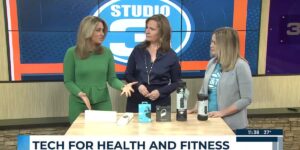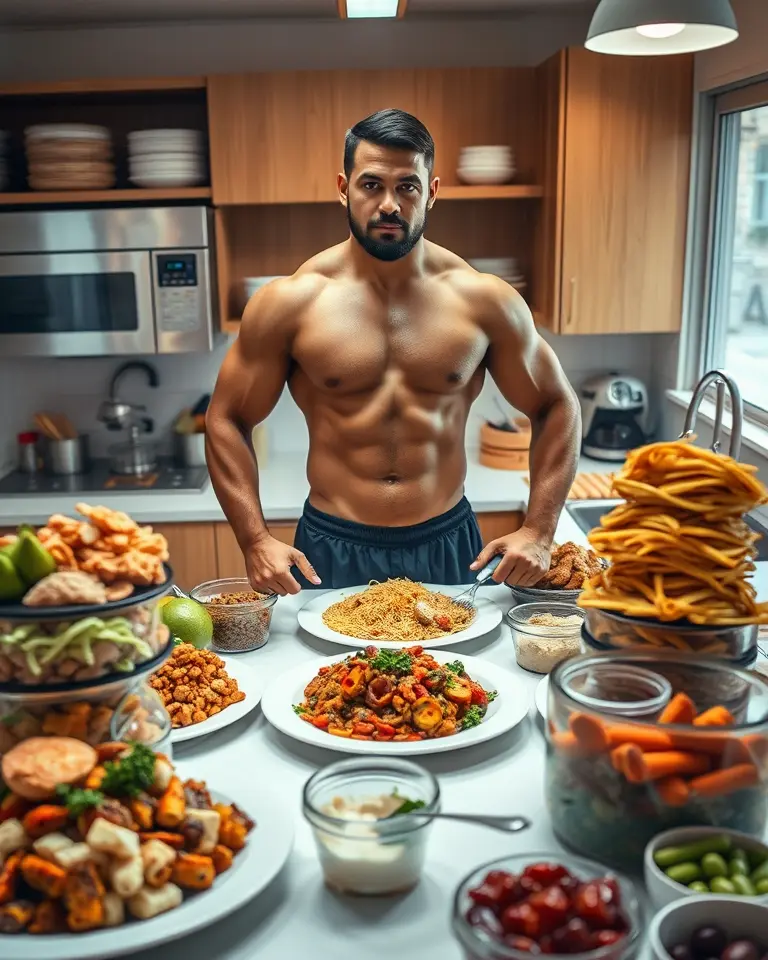For elite athletes and fitness champions, maintaining peak performance requires a strategic approach not just to training but also to nutrition. Consuming 5,000 calories a day is not about indulging in excessive amounts of unhealthy food; it’s about fueling the body with the right nutrients to support intense training and muscle recovery. This article explores how a fitness champion structures their diet to meet such high caloric needs, emphasizing the importance of balance, timing, and food quality.
The Science Behind 5,000 Calories
The average adult requires around 2,000-2,500 calories per day to maintain their weight. However, athletes engaged in high-intensity training can burn significantly more calories. A 5,000-calorie diet is often necessary for those who train for multiple hours daily, especially if the goal is to build muscle mass or maintain a high level of energy for endurance activities. These athletes may include professional football players, swimmers, and bodybuilders.
Macronutrient Breakdown
A balanced 5,000-calorie diet doesn’t just focus on total calories, but also on the proportions of macronutrients: carbohydrates, proteins, and fats.
- Carbohydrates: Should make up the majority of the intake, roughly 50-65% of total calories. Carbs are the primary source of energy for high-intensity activities, crucial for fueling muscles and replenishing glycogen stores. Complex carbohydrates like whole grains, fruits, and vegetables are preferred over simple sugars.
- Protein: Essential for muscle repair and growth, protein should constitute around 15-25% of daily calories. Lean sources such as poultry, fish, tofu, and legumes are preferred to minimize saturated fats.
- Fats: Important for hormone regulation and overall health, fats should make up about 20-30% of the diet. Healthy fats from sources like avocados, nuts, and olive oil should be prioritized.
Caloric Needs Based on Activity Level
The amount of calories an athlete needs varies based on the intensity and duration of their training. Here’s a rough guide:
- Mild Activity: No structured training; rest days require 12-14 calories per pound of body weight.
- Moderate Exercise: Up to one hour of exercise requires 15-17 calories per pound.
- High Activity: 1-2 hours of moderate-intensity exercise requires 18-24 calories per pound.
- Very High Activity: 3+ hours of training requires 24-29 calories per pound.
For instance, a 200-pound athlete engaged in very high-level training could need anywhere between 4,800 to 5,800 calories a day.
Sample Meal Plans for a 5,000-Calorie Diet
Consuming 5,000 calories can seem daunting, so it’s important to spread the intake throughout the day. Here are some sample meal plans from fitness champions and nutritionists:
49ers Lineman Meal Plan
According to the 49ers Coordinator of Nutrition, here is a 5,000 calorie plan for players looking to gain weight:
- Breakfast (7:00-8:00 AM):
- 3 large eggs
- 1/2 cup egg whites
- 1 cup steel cut oatmeal
- 12 almonds
- 1 cup blueberries
- 8 fl oz orange juice
- Mid-Morning Snack (9:30-10:30 AM):
- Chocolate PB Gainz Smoothie (Whey Protein Isolate, 2 Scoops; Chocolate Milk, 12 fl oz; Peanut Butter, 2 Tbsp; Avocados, 1/4 avocado sliced; Olive Oil, 2 Tbsp)
- Lunch (11:30 AM-12:30 PM):
- 6 oz Wild Salmon
- 2 Cups Shredded Mixed Greens Salad
- 1 Tbsp Olive Oil
- 2 Tbsp Balsamic Vinegar
- 1 1/2 Cups Brown Rice
- 1/2 Avocado Sliced
- 8 fl oz 1% Chocolate Milk
- Afternoon Snack (2:00-3:00 PM):
- 1 1/2 Cups Small Curd Cottage Cheese
- 1 Medium Banana
- 12 Almonds
- Dinner (5:30-6:30 PM):
- 6 oz Chicken Breast
- 1 Medium Sweet Potato
- 2 Cups Mixed Vegetables
- 10 oz Naked Juice (Green Machine)
- Before Bed Snack (8:00-9:00 PM):
- Chocolate PB Gainz Smoothie
Chris Bumstead’s Off-Season Diet
Professional bodybuilder, Chris Bumstead, uses a 5,000-calorie diet during his bulking season.
- Breakfast:
- Coffee with mushrooms and chocolate sea salt
- Two scoops of CBUM Itholate Protein™ and one scoop of glutamine in water
- Two whole cinnamon raisin bagels with Ghee butter
- Mid-morning:
- 185 grams of ground turkey over 300 grams of white rice with 15 grams of olive oil
- Peanut butter protein bar
- Mini rice cakes
- Lunch:
- MegaFit Meals Steak and Sweet Potatoes
- Post-workout:
- 180 grams of brown pasta with 100 grams of ground beef and 100 grams of ground turkey covered in 250 milliliters of tomato sauce.
- Dinner:
- 170 grams of ground beef, 300 grams of sweet potato, and half an avocado.
- Evening Snack:
- 80 grams of oats, 32 grams of almond butter, and one scoop of whey protein.
Sample 5,000 Calorie Menu
Another example of a high-calorie menu includes:
- Breakfast:
- 2 cups of instant oatmeal
- 1 tbsp of brown sugar
- 1 english muffin
- 2 tbsp of jelly
- 1 banana
- Snack:
- 8oz of low-fat yogurt
- 1/2 cup of granola
- 20oz bottle of Gatorade
- 2 granola bars
- Lunch:
- 1 cup of mixed vegetables
- 1 1/2 cups of rice
- 6oz of grilled chicken breast
- 2 bread sticks
- 1 tbsp of butter
- Snack:
- 1 Apple
- 30 cheese crackers
- 16oz of fruit punch
- Snack:
- 1 cup of Honey Bunches of Oats
- 1 cup of skim milk
- Dinner:
- 3oz lean ground beef
- 2 cups of pasta
- 1 cup of marinara sauce
- 2 pieces of garlic bread
- 2 cups of romaine lettuce
- 2 tbsp of ranch dressing
- Snack:
- 1 Grilled cheese
- 1 cup of skim milk
- 2 tbsp of Hersey’s chocolate syrup
Key Elements of a 5,000-Calorie Plan
Several principles are common across these meal plans:
- Frequent Meals: Eating every 2-3 hours ensures a consistent supply of energy and nutrients. This also prevents feeling overly full and allows for better digestion and absorption.
- Pre- and Post-Workout Nutrition: Consuming a mix of carbohydrates and protein before training provides readily available energy, while post-workout meals focus on replenishing glycogen and repairing muscle tissue. The ideal ratio is often around 3:1 carbohydrates to protein.
- Nutrient-Dense Choices: Prioritizing whole, unprocessed foods that provide essential vitamins and minerals alongside the high calories.
- Healthy Fats: Incorporating sources of good fat, like avocados, nuts, seeds, and olive oil, is key to hormone regulation and long-term health.
- Hydration: Consuming ample water and electrolyte-rich drinks is crucial to stay hydrated, as high-intensity training and high calorie intake can lead to increased fluid loss.
Practical Tips for Implementing a 5,000-Calorie Diet
Implementing a 5,000-calorie diet requires planning, consistency, and awareness. Here are some tips to make it manageable:
- Meal Prep: Prepare meals in advance to avoid unhealthy choices when pressed for time. Having a ready-to-go meal plan ensures you meet your caloric goals.
- High-Calorie Snacks: Keep high-calorie, nutrient-dense snacks readily available, such as nuts, seeds, nut butters, dried fruits, and granola.
- Add Healthy Fats: Incorporate avocado, cheese, nuts, and seeds to meals and snacks to increase calorie intake without adding a lot of extra food.
- Calorie-Dense Drinks: Opt for smoothies with added milk, nut butter, and fruits to boost caloric intake. 100% fruit juices can also help boost calorie intake.
- Don’t Skip Meals: Consistency is important, so avoid skipping meals, especially breakfast. If you skip breakfast, add an extra snack/smoothie to your day.
- Add Portion Sizes: Increase your serving sizes at each meal, which adds additional calories without requiring drastic changes.
- Monitor Progress: Regularly track your body weight and adjust your caloric intake as needed.
Potential Challenges and How to Overcome Them
A 5,000-calorie diet can present challenges, such as:
- Digestive Issues: Eating large amounts of food can lead to digestive discomfort. Combat this by eating smaller, frequent meals, and avoiding high-fiber foods before workouts.
- Time Commitment: Preparing and eating so much food can be time-consuming. Planning and preparing food ahead of time can help save time during busy weeks.
- Maintaining a Balanced Diet: It’s easy to rely on processed foods for quick calories. Prioritize whole, nutrient-rich foods to ensure a balanced diet.
Conclusion
For fitness champions, consuming 5,000 calories a day is a calculated strategy to fuel intense training, promote muscle growth, and optimize performance. It’s not about eating anything and everything; it’s about consuming the right balance of macronutrients, timing meals effectively, and prioritizing nutrient-dense food sources. By adhering to these principles, athletes can sustain their rigorous training regimens and reach their peak potential. While this dietary approach may not suit the average person, it underscores the importance of tailored nutrition for achieving extraordinary fitness goals.







